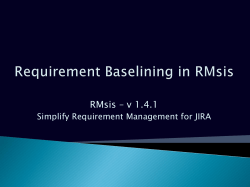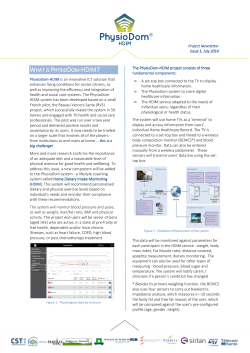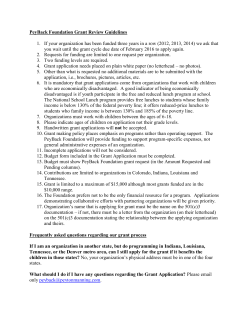
U.S. Department of Education Grant Performance Report Cover Sheet (ED 524B)
U.S. Department of Education Grant Performance Report Cover Sheet (ED 524B) OMB No. 1894-0003 Exp. 04/30/2014 Check only one box per Program Office instructions. [ ] Annual Performance Report [ ] Final Performance Report General Information 1. PR/Award #: P031S130057 2. Grantee NCES ID#: N/A (Block 5 of the Grant Award Notification - 11 characters.) (See instructions. Up to 12 characters.) 3 Project Title: Building Pathways of Persistence and Completion (Enter the same title as on the approved application.) 4. Grantee Name (Block 1 of the Grant Award Notification.): Mt. San Antonio Community College District 5. Grantee Address (See instructions.) 1100 N. Grand Avenue, Walnut, CA 91789 6. Project Director (See instructions.) Name:_Lisa Rodriguez, Ph.D. Title: Director, Title V grant Ph #: (909) 274 -4177 Ext: ( ) Fax #: ( ) ________ - __________ Email Address: lisa.rodriguez@mtsac.edu Reporting Period Information (See instructions.) 7. Reporting Period: From: 10/1/2013 To: 3/31/2014 (mm/dd/yyyy) Budget Expenditures (To be completed by your Business Office. See instructions. Also see Section B.) 8. Budget Expenditures Federal Grant Funds Non-Federal Funds (Match/Cost Share) $85,594.00 N/A a. Previous Budget Period b. Current Budget Period c. Entire Project Period (For Final Performance Reports only) Indirect Cost Information (To be completed by your Business Office. See instructions.) 9. Indirect Costs a. Are you claiming indirect costs under this grant? ___Yes _X__No b. If yes, do you have an Indirect Cost Rate Agreement approved by the Federal Government? ___Yes ___No c. If yes, provide the following information: Period Covered by the Indirect Cost Rate Agreement: From: _____/ _____/_______ To: _____/_____/_______ (mm/dd/yyyy) Approving Federal agency: ___ED ___Other (Please specify): ___________________________________________________ Type of Rate (For Final Performance Reports Only): ___ Provisional ___ Final ___ Other (Please specify): _______________ d. For Restricted Rate Programs (check one) -- Are you using a restricted indirect cost rate that: ___ Is included in your approved Indirect Cost Rate Agreement? ___ Complies with 34 CFR 76.564(c)(2)? Human Subjects (Annual Institutional Review Board (IRB) Certification) (See instructions.) 10. Is the annual certification of Institutional Review Board (IRB) approval attached? ___Yes ___ No X N/A Performance Measures Status and Certification (See instructions.) 11. Performance Measures Status a. Are complete data on performance measures for the current budget period included in the Project Status Chart? ___Yes _X_ No b. If no, when will the data be available and submitted to the Department? 12/10/2014 (mm/dd/yyyy) 12. To the best of my knowledge and belief, all data in this performance report are true and correct and the report fully discloses all known weaknesses concerning the accuracy, reliability, and completeness of the data. Lisa Rodriguez, Ph.D. Name of Authorized Representative: Title: Project Director _____________________________________________________ Signature: 1 Date: 4/30/2014 U.S. Department of Education Grant Performance Report (ED 524B) Executive Summary OMB No. 1894-0003 Exp. 04/30/2014 PR/Award # (11 characters): P031S130057 (See Instructions) The Mt. San Antonio Title V grant, “Building Pathways to Completion and Transfer,” while at the midterm mark, is beginning to implement our stated goals and objectives. Important groundwork is now gaining momentum in re-organizing, prioritizing, and solidifying the infrastructure that will produce maximum benefit to our students. This Executive Summary will provide narrative in four main areas of implementation: personnel, teams, implementation strategies update, and budget. Personnel: Although only 2 key personnel positions exist within the grant of the 13 types of hires to support our goals, the less than full-time positions are vital to our project and emphasis on implementing their hiring has been a priority. Since the beginning of our reporting period (October 2013), the Project Director (hired November 2013), Educational Researcher (hired November 2013), Web Developer (hired December 2013), and Clerical Specialist (hired March 2014) are in place as have the Faculty Coordinators to develop and oversee the academic program cohorts. Hiring is in mid-stage for the Counselor Coordinator and Tutorial Services Specialist (expected start dates for both are June and July respectively), as are the hourly employees who will work throughout the remainder of the reporting year. Although we have experienced delays typical to academic institutions such as holidays or need to first hire regular teaching faculty, hourly positions such as tutors are in place and have begun to serve students within our cohorts, which is to say vacancy has not stalled progress. Teams: As this is a funded-down grant, and our college has undergone a significant leadership change within the past year (a new VP of Instruction to whom the Project Director reports), a fresh visioning of the relationships, operations, and teambuilding efforts took priority in the first three months of the award. To this end we have: 1) identified the Steering Committee (which met this month to refine and propose modifications to the original objectives and study the budget further to make any necessary recommendations for best avenues to maximize it), 2) identified the Work Groups necessary to carry out the goals, 3) brought on board an External Evaluator who made a site visit in April to assist in bringing our components up to date and identify next steps, 4) established a grant staff presence on campus with all relevant partners. Implementation of Year 1 Goals: 1) Students make informed choice of educational goal through targeting support services, career assessment, and educational planning: We have updated DegreeWorks to automate and simplify this process for students. We expect to have a large increase in students using this educational planning system (MAP) as soon as Summer through the efforts of our Title V Web Developer and Student Services faculty counselors. We have identified an upgrade to the Career software subscription and will upgrade this Summer, as well as use other electronic career planning tools with our Summer Boot Camps and Cohorts in the Fall. 2) Provide support services that accelerate students into and promote retention in college-level coursework (improved enrollment/matriculation activities and referral to services): the PD, in the absence of the yet to be hired Counselor Coordinator, has formed a work group consisting of faculty counselors, faculty from the English and Math departments, and staff from two major tutoring centers on campus to evaluate what is in place now and how to expand/revise efforts to achieve our objectives. The group is expected to have a plan by the end of the Summer for implementation in the Fall. 3) Create sustainable and scalable cohort models that move students quickly into college-level coursework and promote faster completion of certificate/degree/transfer programs in specific disciplines: We have identified two new programs to replace the two originally identified in the grant narrative (which are no longer feasible/viable), have had extensive planning sessions with the VP of Instruction, Academic Deans in Technology/Health, Business, and Humanities to launch four of the six cohorts in Spring and Summer, with the final two cohort to begin in the Fall. 2 4) Increase and enhance communication with students through student testimonials, mixed media messages, and faculty engagement: In conjunction with Title V staff (Educational Researcher Web Developer, PD, ) and campus staff (Marketing and IT), we have identified survey questions to capture student preferences for receiving information (in alignment with an annual national study by ECAR/EDUCAUSE). The survey will be deployed in Fall. Faculty engagement strategies are in the planning phases. The PD will participate in the Learning Community Institute on campus in May as part of this planning process and identify a Title V committee to ensure this goal is met. 5) Provide faculty with professional development opportunities and resources that promote student success: We have funded one faculty member in English to attend the Supplemental Instruction training conference in May, and will fund seven faculty and staff to attend the “Strengthening Student Success” Conference in the Fall. Initial planning meetings have taken place, and more are underway in the month of May, with the new Professional and Organizational Development and Employee Engagement Manager and the Faculty Coordinator and Co-Chair of the Professional Development Committee to set goals, time-lines, and plan our CTE faculty/counselor retreat (slated for the end of Summer) as well as other PD opportunities supported by the grant. Budget: This area of strategic planning has been the most time consuming but agreeably the most important next to team building. In the first Steering Committee, the group agreed to review a funding criteria worksheet prepared by the Project Director in order to establish priority funding. That is, although our budget will not fluctuate more than 10% of the award between any given category, nor move funds into zero funded categories, we will be using savings from some areas to augment the most important parts of the grant effort: academic support for students in the form of tutoring, lab assistants, supplemental instruction and peer advising. Although we have only expended 13% of our available budget, we are quickly ramping up to pay out our hourly development stipends to faculty and other hourly grant employees, mostly in the areas of the academic cohorts and the Summer Boot Camp in addition to upcoming hires for two key positions. We have worked diligently as a committee to identify priority for where to allocate our funds given the changed financial landscape since the grant was authored. The extra funds will best serve our students in the areas of direct instruction, as well as to supplement faculty development in innovative teaching strategies, both on and away from campus at professional development conferences. 3 Title V Mt. San Antonio College, CA PR/Award # P031S130057 April 23, 2014 Objective & Key Personnel Update Request Request One: Modify Objective #1.1 Original Objective (page 20) The number of students with a declared educational goal of earning a certificate/degree and/or transfer will increase from a baseline of 21,050 students in Fall 2011 by 1% (Fall 2013), 3% (Fall 2014), 5% (Fall 2015), 7% (Fall 2016), and 10% (Fall 2017). Requested Modification: The number of enrolled students with an educational plan will increase from a baseline of 6,902 students in Fall 2013 by 3% (Fall 2014), 7% (Fall 2015), 11% (Fall 2016), 15% (Fall 2017), and 20% (Fall 2018). Rationale: Objective 1.1 as it was originally written was very similar to objective 2.1. However, at the time it was written, the ability to track and monitor student educational plans was very limited. Since the grant was written in 2012, our institution has implemented Degree Works which allows students and counselors to access educational plans through their on-‐line portal accounts. As a result, we have the capability to measure our efforts of providing students clear pathways to their educational goals better than we could before. Modifying this objective is a more precise way to measure whether we are meeting our goal of assisting students with their path to success. Additionally, the similarity between the original objective 1 and 2 meant we would be measuring nearly the same thing with two different percentage goals. If a student does not have a declared major (aka undecided) they have not decided if they are earning a certificate/degree and or transfer and vice versa. The only difference between the two objectives was the percentage increase we anticipated year to year. Request Two: Modify Objective #2 Original Objective (page 20) The number of students with a declared major program of study will increase from a baseline of 15,522 in Fall 2011 by 3% (Fall 2013), 7% (Fall 2014), 11% (Fall 2015), 15% (Fall 2016), and 20% (Fall 2017). Requested Modification: The number of enrolled students with an educational plan and with a declared major program of study will increase from a baseline of 5,876 in Fall 2013 by 1% (Fall 2014), 3% (Fall 2015), 7% (Fall 2016), 11% (Fall 2017), and 15% (Fall 2018). Rationale: The three modifications we are requesting for this objective are adding the word “enrolled” and “with an educational plan” to further define the population under investigation and the percentages of growth we expect. If modifications to Objective 1.1 are granted, then we would expect the percentage of students with a declared major to be less than those with an educational plan, so we are requesting smaller percentage growths in objective 2.1 than in 1.1. 1 Request Three: Modify Objectives #3.1 and 3.2 Original Objective (page 20) Objective 3.1: The rate at which students are placed into developmental English (ENGL 67 or lower) will decrease among pilot students from an average baseline of 77% in 2010-‐11 to 76% (2012-‐13), 74% (2013-‐14), 72% (2014-‐15), 70% (2015-‐ 16), and 67% (2016-‐17). Objective 3.2: The rate at which students are placed into developmental mathematics (MATH 51 or lower) will decrease among pilot students from an average baseline of 67% in 2010-‐11 to 66% (2012-‐13), 64% (2013-‐14), 62% (2014-‐15), 60% (2015-‐16), and 57% (2016-‐17). Requested Modification: The rate at which students are placed into developmental English (ENGL 67 or lower) will decrease among pilot students by 2% in 2014-‐15, 4% (2015-‐16), 6% (2016-‐17), 8% (2017-‐18). And The rate at which students are placed into developmental mathematics (MATH 51 or lower) will decrease among pilot students by 2% in 2014-‐15, 4% (2015-‐16), 6% (2016-‐17), 8% (2017-‐18). Rationale: The original objective was written with assumed levels of placement among our pilot students. Implementation of our pilot students is expected to commence at the beginning of year two of this grant. We do not know what the placement rates will be for this group. We therefore propose percentage growths that are not dependent on a known level that, at this point in time, are unknown. Request Four: Modify Objectives #4.1 Original Objective (page 20) The rate at which students persist from fall term to fall term will increase among pilot full-‐time students from an average of 76% in Fall 2010 to 78% (Fall 2013), 80% (Fall 2014), 82% (Fall 2015), 84% (Fall 2016), and 86% (Fall 2017). Requested Modification: The rate at which students persist from fall term to fall term will increase among pilot students by 2% in Fall 2015 and 4% (Fall 2016), 6% (Fall 2017), 8% (Fall 2018). Rationale: The original objective was written with assumed levels of persistence among our pilot students and that our pilot students would be full-‐time students. Implementation of the pilot project is expected to commence at the beginning of year two of this grant. We do not know what the rates will be for this group. We therefore propose percentage growths that are not dependent on a known level that at this point is unknown. Additionally, we know that some of our cohort groups will include part-‐time students and we want to include them in our analysis. Therefore, we would like to remove the word “full-‐time” from the objective. 2 Request Five: Modify Objectives #5.1 Original Objective (page 20) The number of students receiving certificates and/or degrees will increase from a baseline of 2,338 in 2010-‐11 by 3% (2012-‐13), 6% (2013-‐14), 10% (2014-‐15), 15% (2015-‐16), and 20% (2016-‐17). Requested Modification: The number of students receiving certificates and/or degrees or are job placed will increase among pilot students from a baseline of (to be established) in 2014-‐15 by 3% (2015-‐16), 6% (2016-‐17), 10% (2017-‐18). Rationale: Our institution serves over 30,000 credit students each term, our completion strategies are aimed at students who will participate in our planned cohorts. The impact of these efforts will be better determined if we limit our evaluation to students (pilot) who participate in these efforts. . Also, since several of our cohorts are career technical oriented projects, for some of these students a better measurement might be job placement. Therefore, we would like to add the words, “job-‐placed” to include those students whose primary educational goal is job placement. The baseline for this objective will be established once all the cohorts have been created. Request Six: Modify Objectives #6.1 Original Objective (page 20) The number of students transferring to baccalaureate degree-‐granting institutions within three years of entry into the college will increase from a baseline of 355 (2010-‐11) by 2% (2012-‐13), 4% (2013-‐14), 7% (2014-‐15), 11% (2015-‐16), and 15% (2016-‐17). Requested Modification: The number of pilot students transferring to baccalaureate degree-‐granting institutions within three years of entry into the college will increase from a baseline of (to be established) (2013-‐14) by 2% (2014-‐15), 4% (2015-‐16), 7% (2016-‐17), 11% (2017-‐18). Rationale: The impact of our efforts to assist students achieve their educational goals will be better determined if we limit our evaluation to students (pilot) who participate in these efforts. The baseline for this objective will be established once all the cohorts have been created. KEY PERSONNEL MODIFICATIONS: Original Plan: from “Additional Personnel” – Counselor Coordinators (2 positions at 0.475 FTE for five years) – Oversee and/or develop matriculation activities, student success courses, curricular units on careers, faculty tool kits for just-‐in-‐ time advising, summer boot camps, freshman seminars, and linkages. Requested Modification: These two part-‐time positions will become one full-‐time and therefore move into the “Key Personnel” category to better bring cohesion to activities under the grant. The savings from the staggered hiring of personnel in the first six months of the grant will cover the cost of default fringe benefits of creating a full-‐time position at the institution. In year 3, the Student Services division will fund the position’s fringe benefits throughout year five. Other salary funding structure will not vary. The plan for gradual and final institutionalization (years 4-‐5) remains in place. 3
© Copyright 2025





















